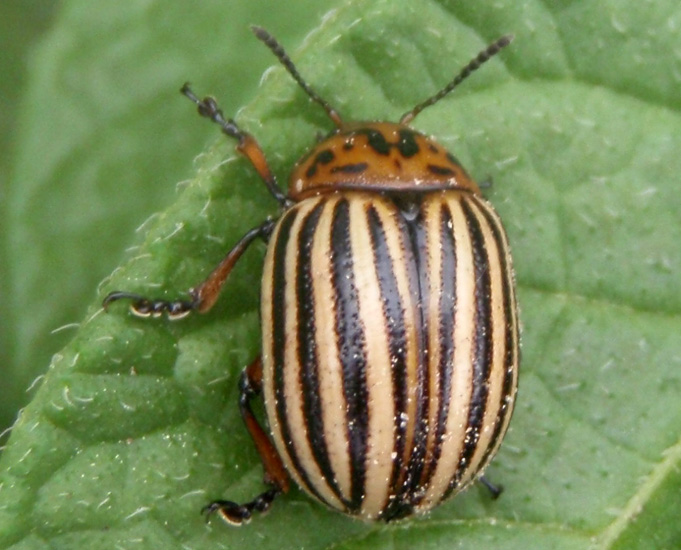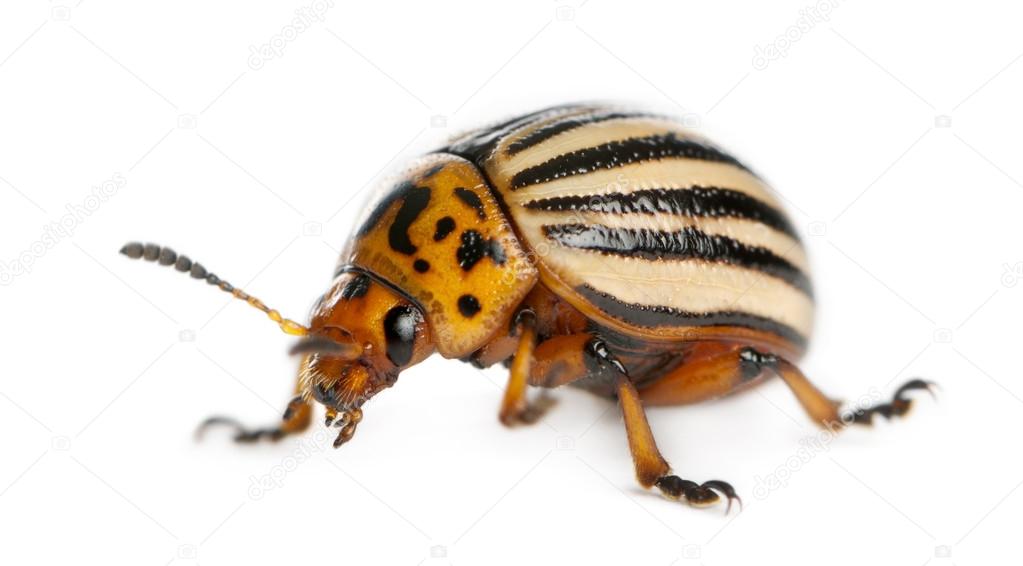This article appears in the November 2017 issue of Potato Grower.
Colorado potato beetle is an insect that is undoubtedly very familiar to the readers of Potato Grower. Just as any other farming enterprise, producing potatoes is subject to myriad different forces, ranging from the amount of precipitation in the mountains 500 miles away, to political stability in the Middle East, to the latest diet fads sweeping throughout the United States and Canada, to behavioral problems plaguing yet another batch of politicians running for office. These are all highly variable, have a tendency to appear out of nowhere, often interact with each other in rather bizarre ways, and usually are impossible to predict with any degree of certainty.
In such a context, a threat of Colorado potato beetle damage remains one of very few stable things in the life of a potato grower, right there along with death and taxes. Despite all human attempts to do something about them, these medium-sized and rather attractive-looking (at least to somebody who is not a potato grower) shiny insects seemingly always linger in the background. Although several chemicals are currently available to keep them at bay, they are always ready to start wreaking havoc as soon as something goes wrong with these compounds.
Developing and improving insecticides has been the main focus of controlling Colorado potato beetles since the middle of 19th century. The necessity of protecting potato crops from beetle damage was actually an important driver behind development of the modern agrichemical industry. The first major success story of using insecticides in agriculture was suppression of this pest in the Midwest in the 1860s through applications of Paris green (cuprous acetoarsenite). Furthermore, efforts to improve Colorado potato beetle control encouraged many important advances in pesticide application equipment, such as compression sprayers, air-blast sprayers, engine-operated sprayers and traction-operated dusters.
 By and large, the chemical approach was successful, as evidenced by the steady growth of potato yields. We have certainly come a long way since the times of Paris green and lead arsenate. Unfortunately, beetle populations did not remain static in the face of adversity, either. This species is characterized by a rather impressive adaptability to pretty much all the chemicals that have been thrown at it over the years. Although each new failure of a popular insecticide sometimes seems to be a great surprise to the parties involved (except, perhaps, the beetles), it is actually something to be expected.
By and large, the chemical approach was successful, as evidenced by the steady growth of potato yields. We have certainly come a long way since the times of Paris green and lead arsenate. Unfortunately, beetle populations did not remain static in the face of adversity, either. This species is characterized by a rather impressive adaptability to pretty much all the chemicals that have been thrown at it over the years. Although each new failure of a popular insecticide sometimes seems to be a great surprise to the parties involved (except, perhaps, the beetles), it is actually something to be expected.
In nature, Colorado potato beetles specialize on eating plants in the nightshade family, of which potato is one representative. To protect themselves from herbivores, these plants produce high amounts of poisons in their foliage. As a result, Colorado potato beetles possess an array of enzymes designed to detoxify these phytochemicals inside their bodies. Tellingly, efforts to breed a potato resistant to beetle damage have been, so far, largely unsuccessful. Many detoxification enzymes, perhaps with some modifications, are also capable of destroying insecticides developed by humans. Simply put, Colorado potato beetle is not an easy organism to poison.
Even when successful in killing target pests, insecticides are being constantly scrutinized for their effects on non-target organisms. Potential contribution of imidacloprid to worldwide decline in bees and other pollinators is one example of such a concern, and there are many others. Consequently, a particular chemical may be lost to growers not because of resistance development in insect populations, but because of its withdrawal from the market due to environmental considerations. End result to a grower, however, is the same.
When our ability to poison Colorado potato beetles becomes questionable, starving them to death may be another option. Obviously, I do not advocate that potato farmers switch to growing something else. Potato is the most nutritionally valuable staple crop grown by humans, and I have dedicated most of my career to finding better ways to protect it from insect pests. One way to make beetles hungry is to make potato plants inedible to them. Unfortunately, as mentioned above, breeding attempts carried out in this direction have been largely unsuccessful. One big challenge is that potato tuber is a modified potato stem. Therefore, changing stems (and the leaves they carry) to make them inedible to beetles while keeping tubers edible to humans is a challenge.
 Another approach to inducing starvation in Colorado potato beetles is moving food away from them. Temporary food withdrawal in the form of crop rotations has been repeatedly shown to be useful in reducing beetle populations. When the need arises, Colorado potato beetles can be highly mobile and fly over long distances. Nevertheless, although some of them will eventually find a rotated field, most will not. The ones that will are likely to be delayed in the onset of feeding and laying eggs compared to the beetles that simply need to re-emerge within the previous year’s crop.
Another approach to inducing starvation in Colorado potato beetles is moving food away from them. Temporary food withdrawal in the form of crop rotations has been repeatedly shown to be useful in reducing beetle populations. When the need arises, Colorado potato beetles can be highly mobile and fly over long distances. Nevertheless, although some of them will eventually find a rotated field, most will not. The ones that will are likely to be delayed in the onset of feeding and laying eggs compared to the beetles that simply need to re-emerge within the previous year’s crop.
Interestingly, our recent study shows that Colorado potato beetles that are deprived of food and water turn on each other, start fighting, and eventually cannibalize weaker and smaller individuals in the group. It has been long known that larvae in this species cannibalize eggs. Furthermore, female beetles often lay special non-viable eggs that are specifically designated as food for neonate larvae hatching from viable eggs. However, we demonstrated that when faced with starvation, adults also resort to cannibalism. Under natural conditions, this potentially means an additional source of mortality for the beetles that find themselves on rotated fields planted to unsuitable crops. Not only will they deplete their energy reserves in the often futile search for edible host plants, they can also be devoured by larger and more aggressive members of their own species.
It is tempting to envision a world where desperate hordes of hungry Colorado potato beetle cannibals roam post-apocalyptic landscapes of current-season barley fields, while lush, green, undamaged potato crops are blossoming on rotated fields nearby. Unfortunately, such a fantasy world is unlikely to materialize. While reducing overall beetle numbers, cannibalism will actually help the largest and strongest of them to survive and eventually migrate to potato fields. With a single Colorado potato beetle females producing 600 or more eggs, subsequent perpetuation of the species is very likely.
Throughout my career as an applied agricultural entomologist, I have often encountered an expectation that either I, or my more intelligent and hardworking colleagues, ought to discover a silver-bullet solution to a particular insect problem. The entire history of Colorado potato beetle control proves that such an expectation is often unrealistic, at least in the medium- to long-term. It also highlights the importance of practicing integrated pest management. While neither insecticides nor crop rotation will solve the beetle problem once and for all, their combined use is likely to provide more sustainable crop protection compared to each technique used alone.